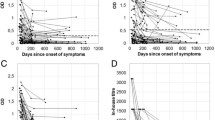Summary
Ten patients with chronicYersinia enterocolitica infections are described. The initial diagnosis was made by culture, significant agglutinin titres and indirect immunofluorescence (IF) on biopsies. During the chronic phase, culture and agglutinin titres were negative, but specific serum IgA and IgG antibodies reactive with at least two, i.e. the 36 kDa and the 46 kDa, virulence-associated released proteins were demonstrated in nine patients by immunoblot techniques. One patient had only IgG antibodies. The chronically elevated IgA production was the result of chronic stimulation of the gut-associated lymphoid tissue by virulent persistentYersinia antigen, which was identified by IF with O-specific antiserum and monospecific antiserum to the 46 kDa released protein in biopsies. VirulentYersinia bacilli were demonstrated in the intestinal mucosa and in the lymphoid tissue of the submucosa associated with macrophages in patients with chronic ileitis and arthritis, in granulomatous centres of lymph nodes in patients with chronic lymphadenopathy and in portal infiltrates in a patient with chronic hepatitis. Recognition of persistentYersinia infections may have therapeutic implications.
Zusammenfassung
Zehn Patienten mit chronischerYersinia enterocolitica-Infektion werden beschrieben. Die Anfangsdiagnose war mittels positiver Kulturen, signifikanter Agglutinationstiter und immunhistologischem (IF) Yersinia-Nachweis in menschlichem Biopsiematerial gestellt worden. Während der chronischen Phase waren Kultur und Agglutinationstiter negativ, aber im Serum von neun Patienten waren mit Immunoblot spezifische IgA- und IgG-Antikörper gegen mindestens zwei, d. h. die 36 kDa und 46 kDa Virulenz-assoziierten Proteine nachzuweisen. Ein Patient hatte nur IgG-Antikörper. Die chronisch erhöhte IgA-Produktion war verursacht durch chronische Stimulierung des intestinalen lymphatischen Gewebes durch virulente, persistierendeYersinia-Antigene, die mittels IF mit O-spezifischem Antiserum und monospezifischem Antiserum gegen das 46 kDa Virulenz-Protein in Biopsiematerial identifiziert werden konnten. VirulenteYersinia-Bazillen lagen in Biopsien von Patienten mit chronischer Ileitis und Arthritis tief in der Darmmukosa und im lymphoiden Gewebe der Submukosa, assoziiert mit Makrophagen. Sie wurden auch in Lymphknoten von Patienten mit chronischer Lymph-adenopathie nachgewiesen und in portalen Infiltraten eines Patienten mit chronischer Hepatitis. Der Nachweis persistierenderYersinia-Infektionen kann therapeutische Konsequenzen haben.
Similar content being viewed by others
Literature
Bottone, E. Yersinia enterocolitica. A panoramic view of a charismatic organism. CRC Crit. Rev. Microbiol. 5 (1977) 211–241.
Hoogkamp-Korstanje, J. A. A. Yersiniosis in childhood. In:Simon, C., Wilkinson, P. (eds.): Diagnosis of infectious diseases — new aspects. 1st ed. Schattauer Stuttgart-New York 1986, pp. 69–77.
Editorial: Yersiniosis today. Lancet I (1984) 84–85.
Hoogkamp-Korstanje, J. A. A. Antibiotics in yersinia infections. J. Antimicrob. Chemother. 20 (1987) (123–131).
Van de Pitte, J., Wauters, G., Isebaert, A. Epidemiology ofYersinia enterocolitica infections in Belgium. Contrib. Microbiol. Immunol. 2 (1973) 111–119.
Hoogkamp-Korstanje, J. A. A., De Koning, J., Samsom, J. P. Incidence of human infection withYersinia enterocolitica serotypes O3, O8 and O9 and the use of indirect immunofluorescence in diagnosis. J. Infect. Dis. 153 (1986) 138–141.
Heesemann, J., Algermissen, B., Laufs, R. Genetically manipulated virulence ofYersinia enterocolitica, Infect. Immun. 46 (1984) 105–110.
Heesemann, J., Kalthoff, H., Koch, F. Monoclonal antibodies directed against plasmid-encoded released proteins of enteropathogenic Yersinia. Federation of European Microbiological Societies Letters 36 (1986) 15–19.
Heesemann, J., Gross, U., Schmidt, N., Laufs, R. Immunochemical analysis of plasmid-encoded proteins released by enteropathogenicYersinia species grown in calcium-deficient media. Infect. Immun. 54 (1986) 561–567.
Heesemann, J., Eggers, C. H., Schröder, J., Laufs, R. Serological diagnosis of yersiniosis by the immunoblot technique using plasmid encoded antigens ofYersinia enterocolitica. In:Simon, C., Wilkinson, P. (eds.): Diagnosis of infectious diseases — new aspects. 1st ed. Schattauer, Stuttgart-New York 1986, pp. 79–88.
Pai, C. H., Sorger, S., Lafleur, L., Lachmann, L., Marks, M. I. Efficacy of cold enrichment techniques for recovery ofYersinia enterocolitica from human stools. J. Clin. Microbiol. 9 (1979) 712–715.
Wauters, G. Correlation between ecology, biochemical behaviour and antigenic properties ofYersinia enterocolitica. Contrib. Microbiol. Immunol. 2 (1973) 38–41.
Kalliomäki, J. L., Leino, R. Follow-up studies in joint complications in yersiniosis. Acta. Med. Scand. 205 (1979) 521–525.
Luzar, M. J., Caldwell, J. H., Mekhjian, H., Thomas, F. B. Yersinia enterocolitica infection presenting as chronic enteropathic arthritis. Arthritis Rheum. 26 (1983) 1163–1165.
Larsen, J. H., Hartzen, S. H., Parm, M. The determination of specific IgA-antibodies toYersinia enterocolitica and their role in enteric infections and their complications. Acta Path. Microbiol. Immunol. Scand. Sect. B 93 (1985) 331–339.
Granfors, K., Viljanen, M. K., Tiilikainen, A., Toivanen, A. Persistence of IgM, IgG and IgA antibodies toYersinia in yersinia arthritis. J. infect. Dis. 141 (1980) 424–429.
Granfors, K., Toivanen, A. IgA anti-yersinia antibodies in yersinia-triggered reactive arthritis. Ann. Rheum. Dis. 45 (1986) 561–565.
Bernstein, R. M., Mackworth-Young, C. G., Saverymutu, S. H., Gupta, S., England, J. P. S., Hughes, G. R. V. Yersinia arthritis: demonstration of occult enteritis by indium leucocyte scanning. Ann. Rheum. Dis. 43 (1984) 493–494.
Author information
Authors and Affiliations
Rights and permissions
About this article
Cite this article
Hoogkamp-Korstanje, J.A.A., de Koning, J. & Heesemann, J. Persistence of Yersinia enterocolitica in man. Infection 16, 81–85 (1988). https://doi.org/10.1007/BF01644307
Received:
Accepted:
Issue Date:
DOI: https://doi.org/10.1007/BF01644307




